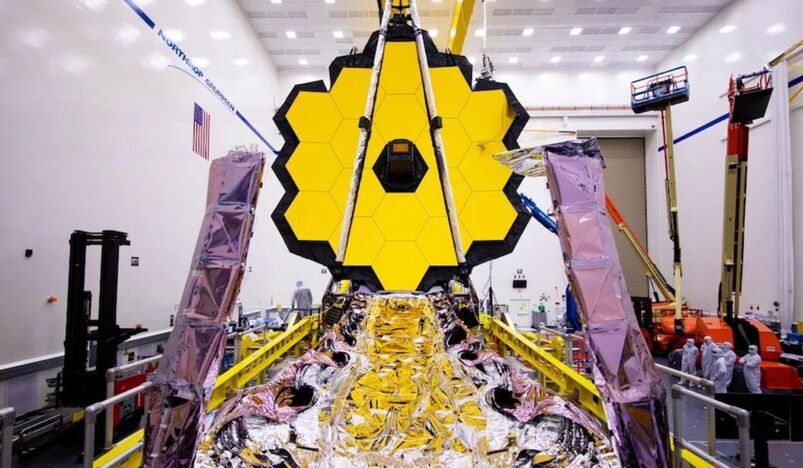
James Webb Space Telescope
NASA is about to send its delicate, $10 billion new observatory — the James Webb Space Telescope — screaming into space.
JWST, or "Webb," is the first major space observatory since the famous Hubble Space Telescope, which launched in 1990 and is still studying the cosmos today. Webb is scheduled to roar into the skies above Europe's Spaceport in Kourou, French Guiana, aboard an Ariane 5 rocket at 7:20 a.m. ET on Saturday, December 25 — Christmas morning.
Watch the historic launch below:
Webb is NASA's attempt to fill a mysterious gap in the historical record of our universe. For telescopes, peering into the distance is also looking back in time. That's because it takes time for light to travel. The farther away an object is, the older its light is by the time it reaches Earth. Astronomers have seen the light of ancient galaxies from 400 million years after the Big Bang. Some of those galaxies were much larger than scientists expected, which means that they grew rapidly in those first 400 million years.
"We have this 13.8-billion-year story — the universe — and we're missing sort of a few key paragraphs in the very first chapter of the story," Amber Straughn, a scientist on NASA's Webb team, said in a November press briefing. "JWST was designed to help us find those first galaxies."
Webb relies on infrared, rather than visual light, to study the cosmos, and it has the largest mirror ever built for a space-based observatory. That makes Webb 100 times more powerful than Hubble. The new telescope should be able to see the very first galaxies forming 100 million years after the Big Bang.
It's also set to study the atmospheres of potentially habitable planets circling other stars, the origins of supermassive black holes, debris of neutron-star collisions, and a slew of other astronomical mysteries.
NASA's new space telescope had a long journey to launch
Astronomers have waited a long time to start using Webb. NASA first conceived of the telescope in the 1990s. It was supposed to cost $500 million and launch in 2011, but redesigns, technical issues, and schedule adjustments drove up the cost and delayed the launch by a decade. This year alone saw three delays, two caused by technical issues in the last month.
Now, finally, Webb is ready to fly. On Saturday morning, the Ariane 5 rocket must carry nearly seven tons of expensive equipment into space.
"You're taking this extraordinarily delicate, precise, state-of-the-art scientific instrument, you're slapping it on a rocket, and for the next eight minutes the explosion from that rocket is following you into outer space," Mike Menzel, NASA's lead mission systems engineer for Webb, said in a NASA video on the subject.
The Ariane 5 should push Webb into space within 27 minutes, but it will be another six months before the telescope can begin conducting science. That's how long its "commissioning" will take — a process that involves unfolding, aligning mirrors, cooling, and calibrating instruments.
Webb has to unfold and travel 1 million miles after launch
It will take about a month just for Webb to reach its destination — an orbit around the sun, trailing Earth by 1 million miles, which is about four times the distance between the moon and Earth. Along the way, the telescope must unfold itself.
Webb is comprised of two major components: a hexagonal mirror made of 18 gold-coated segments and a sunshield the size of a tennis court. Both were too large to fit in any existing rocket, unless NASA folded them up like a drop-leaf table.
In some ways, unfolding the telescope is scarier than launching it.
"Unfolding Webb is hands down the most complicated spacecraft activity we've ever done," Menzel said.
The sunshield blocks the heat of the sun, allowing Webb to cool to a frigid minus 380 degrees Fahrenheit — far colder than any place on Earth. Webb must reach this low temperature in order to detect the faint heat of distant stars and planets, in the form of infrared light. It will take Webb about two months to cool.
After unfolding, Webb will spend about four months aligning and focusing its mirrors. Then the observatory must calibrate its science instruments: four cameras and spectrographs designed to observe the universe in different wavelengths of infrared light.
Webb is heading to space with a controversial name
In addition to technical and schedule challenges, Webb's long journey to launch has stirred controversy. More than 1,000 people, including scientists who applied for observing time with Webb, signed a petition to rename the telescope earlier this year.
The petition argues that the telescope's namesake — James Webb, NASA's second administrator, who oversaw the beginning of the Apollo moon missions — helped enforce government policies discriminating against LGBTQ employees in the 1950s and 60s.
Historian David Johnson's book on the policies, "The Lavender Scare" — a name which refers to the systemic purge of LGBTQ employees from government agencies — cites archival documents, which indicate that prior to his tenure at NASA, when Webb was undersecretary of state, he met with President Harry Truman to discuss enforcing those policies. According to other documents from a 1969 court case, NASA fired at least one employee after an official interrogated him about his sexuality. The firing took place during Webb's tenure as NASA administrator.
NASA conducted a review of the historical documents this summer and ultimately decided against changing the telescope's name.
"We have found no evidence at this time that warrants changing the name of the James Webb Space Telescope," NASA Administrator Bill Nelson said in a statement at the time.
Source: Business Insider
Leave a comment